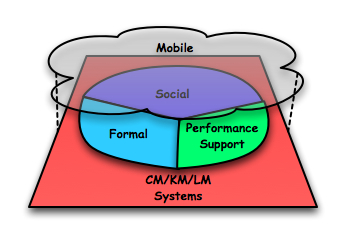I’m still reeling from the intellectual stimulation of the Corporate Learning Trends Conversations on Learning in Organizations that was held a few days ago. One other big learning for me, in addition to the responsibility of learners, was the issue of corporate learning culture. There were two facets to this.
The first facet has to do with the characteristics of a culture that is conducive to collaboration and communication. From a business point of view, it’s about execution and innovation. Execution works in well-defined domains, but innovation requires a variety of factors that characterize a learning organization, including feeling safe to contribute, tolerance for different ideas, and more. Increasingly, I believe, organizations that can innovate fastest will be those that thrive, so successful organizations will be learning organizations.
One of the participants mentioned organizations where you can’t share mistakes, and that’s emblematic of organizations that hire smart, aggressive people and expect them to go out and succeed. Which leads to some smart choices, but also you see repeats of the same mistakes. You don’t really see the effects of that culture until you put in social media, where it becomes obvious whether people are contributing, sharing, etc.
And that was the point I made: to address culture, you have to be explicit about it, it can’t just be background. An organization should choose it’s culture, with a recognition of where it is now. You’ve got to be realistic, or you won’t be able to sell it, which may include being honest about how it has to change. But if you don’t talk about it, make it explicit, support change, reward changet, etc, it can’t happen. It may not be easy, but it should be done.
The second facet has to do with cross-cultural issues. In the session, Allison Anderson of Intel and Dave Wilkins of Mzinga and I discussed the challenges of trying to cross borders and cultures. I pointed to Hofstede’s cultural dimensions via a web tour, in making a point about how different cultures can have values that are contrary to a sharing culture.
I cited an example where a company in a country with a low gender difference (MAS) value had acquired a company from a country with a high gender difference value. The potential problem is that a male engineer from the high gender difference country might not listen to a female engineer from the low difference country, yet this would not be in the company’s best interest.
There are clearly problems in expecting someone to adopt a company culture different than their national culture, and yet there is clearly some advantage. I idealistically suggest it’s worth the effort, if you buttress it with vision and mission, discusison about organizational success, and provide support for the transition.
Like with responsibility for learning, corporate vision & mission, and accepted ethical standards, organizational cultural values needs to be discussed explicitly: defined, modeled, scaffolded, and even evaluated and rewarded. If it’s not explicit, it’s not fair to assume. This is really about taking responsibility for organizational learning at a larger level, architecting it, and leveraging technology as an infrastructure that supports the architecture. It’s meta-learning, and that’s the paradigm I think organizations need to not just survive, but thrive.
 So I’ve been playing with rethinking my Performance Ecosystem conceptualization and visualization. The original had very discrete components, and an almost linear path, and that doesn’t quite convey the reality of how things are tied together. I believe it’s useful to help people see the components, but it doesn’t capture the goal of an integrated system.
So I’ve been playing with rethinking my Performance Ecosystem conceptualization and visualization. The original had very discrete components, and an almost linear path, and that doesn’t quite convey the reality of how things are tied together. I believe it’s useful to help people see the components, but it doesn’t capture the goal of an integrated system. So here’s my current conception. It took me a long time to create the circle with different components! First I had to discover that there were tools to create freeform shapes, and then work to get them to articulate, but I like the kind of ‘rough’ feel of it (appropriate for it’s stage).
So here’s my current conception. It took me a long time to create the circle with different components! First I had to discover that there were tools to create freeform shapes, and then work to get them to articulate, but I like the kind of ‘rough’ feel of it (appropriate for it’s stage).